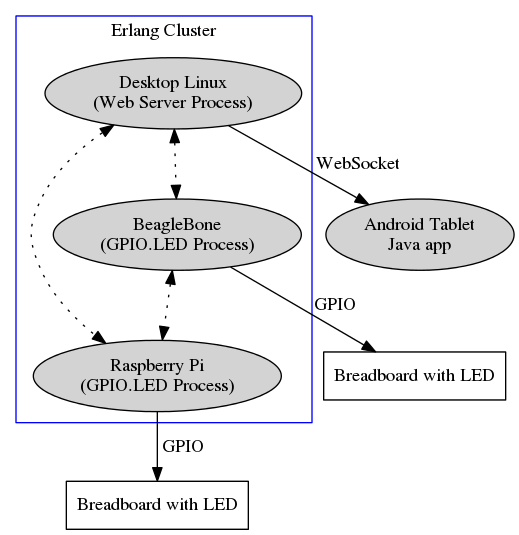Erlang clustering on the Raspberry Pi and BeagleBone with Elixir
December 11, 2015 -I have been looking at Elixir/Erlang clustering with credit card sized computers and using the Phoenix web framework to communicate from the cluster to an Android tablet in realtime.
I am pleasantly surprised at how easy it has been and how little code I had to write for this demo.
In the above video I am running an Erlang cluster consisting of a desktop x86 based PC on Ubuntu, a Raspberry Pi, a BeagleBone Black, and an Android tablet. Each of the nodes are running Erlang/OTP 18.1 and Elixir 1.1.1.
A process written in Elixir on the PC periodically communicates with the Raspberry Pi and BeagleBone to turn on and off LEDs connected via a GPIO pin to a breadboard, and concurrently sends a message to the tablet over a WebSocket in realtime.

Android code
I simply took this Android Phoenix Demo on GitHub, followed the instructions to update the host value, and installed in on a Nexus 7.
Raspberry Pi and BeagleBone Code
On both your Pi and BeagleBone create a file called gpio-led.ex with the following contents:
defmodule GPIO.LED do
use GenServer
#####
# External API
def start_link(pin) do
:os.cmd(to_char_list "echo #{pin} > /sys/class/gpio/export")
:os.cmd(to_char_list "echo out > /sys/class/gpio/gpio#{pin}/direction")
:os.cmd(to_char_list "echo 0 > /sys/class/gpio/gpio#{pin}/value")
GenServer.start_link(__MODULE__, pin, name: __MODULE__)
end
def led_on! do
GenServer.cast __MODULE__, :led_on
end
def led_off! do
GenServer.cast __MODULE__, :led_off
end
#####
# GenServer implementation
def handle_cast(:led_on, pin) do
:os.cmd(to_char_list "echo 1 > /sys/class/gpio/gpio#{pin}/value")
{:noreply, pin}
end
def handle_cast(:led_off, pin) do
:os.cmd(to_char_list "echo 0 > /sys/class/gpio/gpio#{pin}/value")
{:noreply, pin}
end
end
This is a pretty straightforward GenServer. For simplicity I am not using any supervisors in this example, i'll leave that as an exercise for the reader.
If you are curious about what is happening with the GPIO and want to learn more I have written up some information about getting started with Erlang/Elixir and GPIO on the BeagleBone and Raspberry Pi.
Web server code
I started with the Phoenix chat example on GitHub. Clone the repo to your desktop or laptop.
Next create a file called phoenix_chat_example/lib/chat/led_controller.ex with the following contents:
defmodule Chat.LedController do
def blink_leds() do
# Ensure we are connected
true = Node.connect :"beagle@beaglebone.local"
true = Node.connect :"pi@raspberrypi.local"
# Ensure the GPIO.LED servers have started on the Raspberry Pi and BeagleBone
:rpc.call(:"beagle@beaglebone.local", GPIO.LED, :start_link, [23])
:rpc.call(:"pi@raspberrypi.local", GPIO.LED, :start_link, [4])
loop()
end
defp loop() do
Chat.Endpoint.broadcast! "rooms:lobby", "new:msg", %{user: "server",
body: "BeagleBone ON"}
:rpc.call(:"beagle@beaglebone.local", GPIO.LED, :led_on!, [])
:timer.sleep(1000)
:rpc.call(:"beagle@beaglebone.local", GPIO.LED, :led_off!, [])
Chat.Endpoint.broadcast! "rooms:lobby", "new:msg", %{user: "server",
body: "Pi ON"}
:rpc.call(:"pi@raspberrypi.local", GPIO.LED, :led_on!, [])
:timer.sleep(1000)
:rpc.call(:"pi@raspberrypi.local", GPIO.LED, :led_off!, [])
loop()
end
end
This is also straightforward.
- Send a message to a Phoenix Channel (which in turn gets forwarded to the Android app via websocket).
- Periodically make rpc calls to the nodes on the Raspberry Pi and Beaglebone to turn on and off the LEDs
- Sleep for a second
- Repeat
Once started the code will recursively loop forever.
Run the code
ssh to the Raspberry Pi as the root user
# Start an Erlang node
root@raspberrypi:~# iex --name pi@raspberrypi.local --cookie peanut-butter
# Compile
iex(pi@raspberrypi.local)1> c("gpio-led.ex")
ssh to the BeagleBone as the root user
root@beaglebone:~# iex --name beagle@beaglebone.local --cookie peanut-butter
iex(beagle@beaglebone.local)1> c("gpio-led.ex")
On your desktop or laptop run the code as an Elixir Task :
# Start the Phoenix app
$ iex --name desktop@desktop.local --cookie peanut-butter -S mix phoenix.server
# Blink the LEDs
iex(1)> {:ok, pid} = Task.start(fn -> Chat.LedController.blink_leds end)
The LEDs should be turning on and off and you should be seeing messages from Elixir in the Android app.